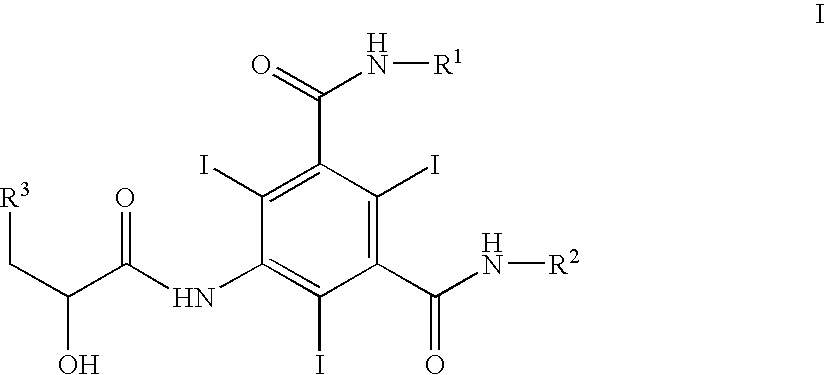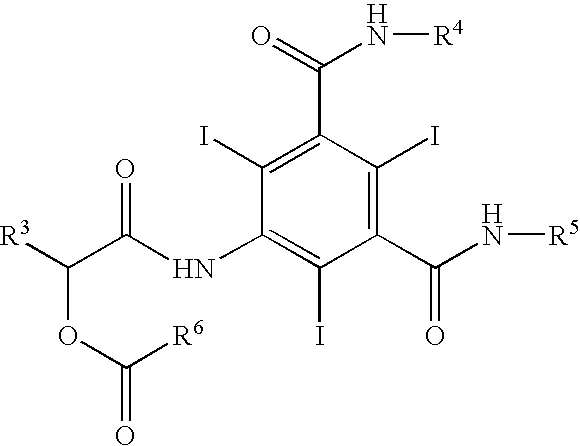Process for the preparation of iopamidol
a technology of iopamidol and iopamidol, which is applied in the preparation of carboxylic acid amides, chemistry apparatus and processes, organic chemistry, etc., can solve the problems of large complex and expensive, complex and expensive final purification of these products, and large quantity of thermal energy required
- Summary
- Abstract
- Description
- Claims
- Application Information
AI Technical Summary
Benefits of technology
Problems solved by technology
Method used
Image
Examples
example 1
N,N′-bis[2-(acetyloxy)-1-[(acetyloxy)methyl]ethyl]-5-amino-2,4,6-triiodo-1,3-benzenedicarboxamide
[0045] A suitable reaction vessel was charged with 50 kg of 5-amino-2,4,6-triiodoisophthalyl dichloride (ATIPA-Cl) and 75 kg dimethylacetamide (DMA) and mixed. A solution of 18.5 kg of 2-amino-1,3-propanediol (serinol) and 30 kg of triethylamine in 45 kg of DMA was added-to the above vessel. The reaction was mixed while gradually elevating the temperature to about 30° C. This temperature was maintained for about 1.5 hours. The reaction was cooled and 0.5 kg of 4-dimethylaminopyridine was added to the vessel followed by the slow addition of 52 kg of acetic anhydride. The reaction was stirred for about 2 hours and quenched by slow addition to water. The solid was isolated by filtration, washed with water and dried (yield: 66 kg; 90%). 1H NMR (300 MHz, DMSO-d6) δ 2.0 (S, 12H), 4.1(m, 8H), 4.3(m, 2H), 5.5 (S,2H), 8.4, 8.7 (2d, 2H). 13C NMR (75 MHz, DMSO-d6) δ 20.8, 46.9, 62.1, 73.5 79.7, 14...
example 2
Preparation of Pentaacetyliopamidol
[0046] The product, 55 kg, prepared in Example 1, was dissolved in 60 kg of DMA. 2(S)-Acetoxypropionyl chloride, 20 kg, was added slowly. The reaction was stirred at room temperature for about 2 hours and quenched by the slow addition of isopropanol. The mixture was neutralized with tributylamine. The pentaacetyliopamidol is collected by filtration, washed with isopropanol and dried (yield. 56 kg, 90%). 1H NMR (300 Mz, DMSO-d6) δ 1.5 (d, 3H), 2.0 (S, 12H), 2.1(2S,3H0, 4.1 (m, 8H), 4.3(m, 2H), 5.2(q, 1 H), 8.8 (d,1 H0, 8.9(t,1H), 10.1(S, 1H). 13C NMR (75 MHz, DMSO-d6) 17.6, 20.8, 47.0, 62.1, 69.4, 90.1, 99.0, 142.4, 149.6, 168.0, 169.1, 169.5, 170.3.
example 3
Preparation of Lopamidol
[0047] A solution of 58 kg of pentaacetyliopamidol in 400 L of methanol containing a catalytic amount, 400 g, of aqueous hydrochloric acid was heated at reflux for about 30 hours. The methanol was removed by distillation and the residue dissolved in water. The acid was neutralized by stirring the solution with an acid-scavenging resin (IRA-68). The resin was removed by filtration and the resulting aqueous solution was passed through a 50 kg column of amberlite XAD-16 resin. The eluant was concentrated to provide an oil and the residue crystallized by heating the oil in a mixture comprising 40 kg of acetonitrile and 150 L of ethanol, followed by cooling. The iopamidol was collected by filtration, washed with ethanol and dried (yield: 34 kg, 74%).
[0048] Specific Rotation [α]D20=−5.0 in methanol. 1H NMR (300 MHz, D2O) δ 1.6(d, 3H), 3.8 (d,8H), 4.2(m, 2H), 4.5(q, 1H). 13C NMR (75 MHz, D2O) δ 21.5, 55.1, 61.8, 70.2, 91.0, 99.8, 144.2, 151.2, 173.8, 178.6.
PUM
| Property | Measurement | Unit |
|---|---|---|
| temperature | aaaaa | aaaaa |
| pH | aaaaa | aaaaa |
| acid scavenging | aaaaa | aaaaa |
Abstract
Description
Claims
Application Information
 Login to View More
Login to View More - R&D
- Intellectual Property
- Life Sciences
- Materials
- Tech Scout
- Unparalleled Data Quality
- Higher Quality Content
- 60% Fewer Hallucinations
Browse by: Latest US Patents, China's latest patents, Technical Efficacy Thesaurus, Application Domain, Technology Topic, Popular Technical Reports.
© 2025 PatSnap. All rights reserved.Legal|Privacy policy|Modern Slavery Act Transparency Statement|Sitemap|About US| Contact US: help@patsnap.com



